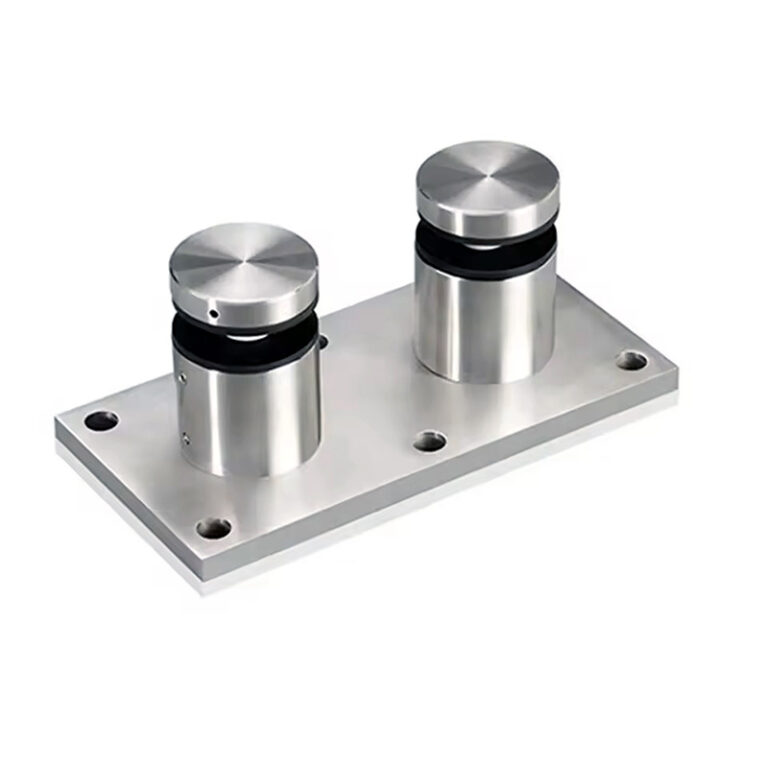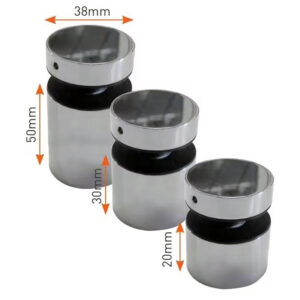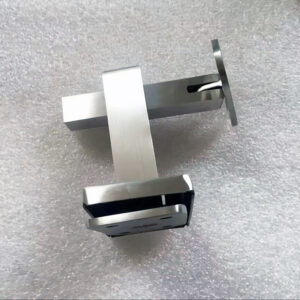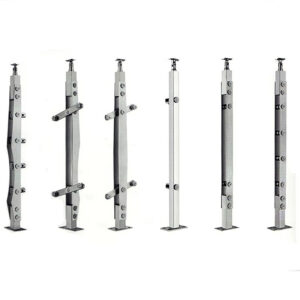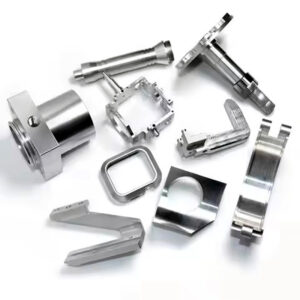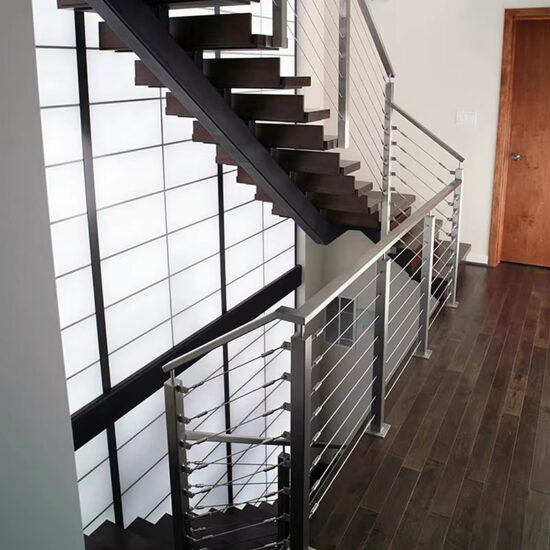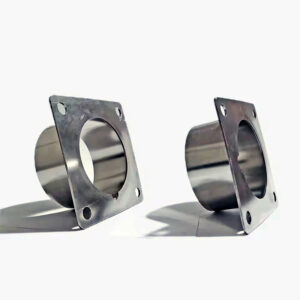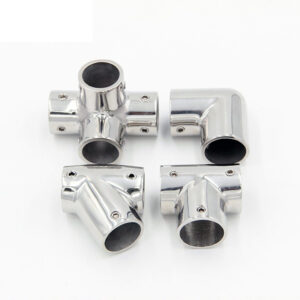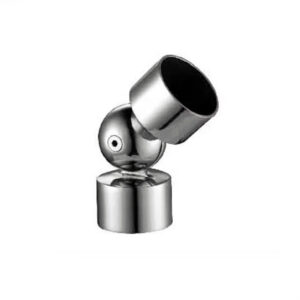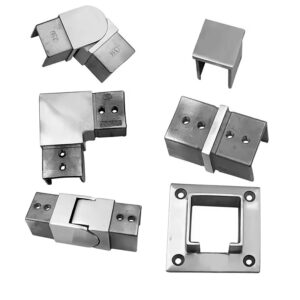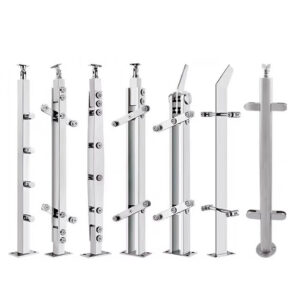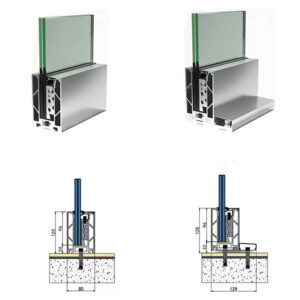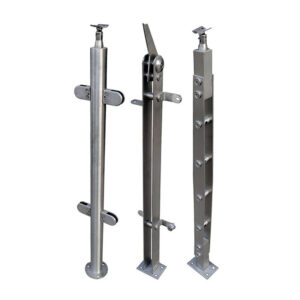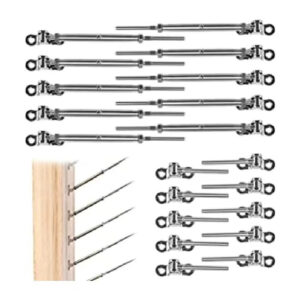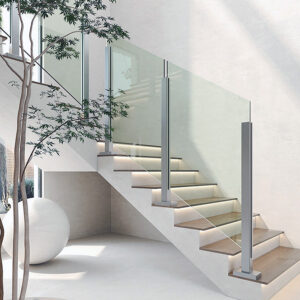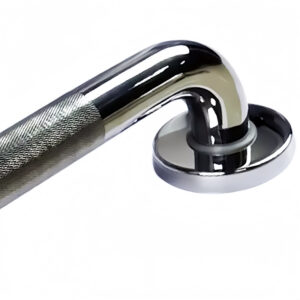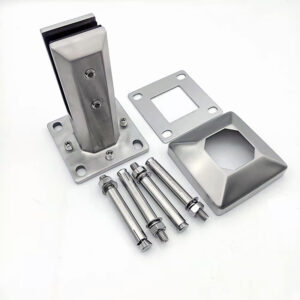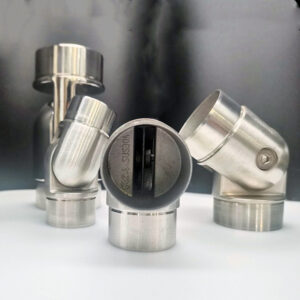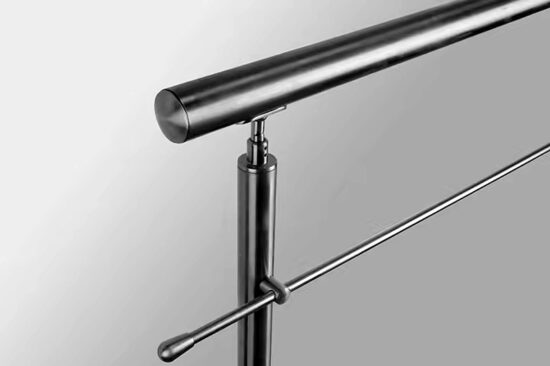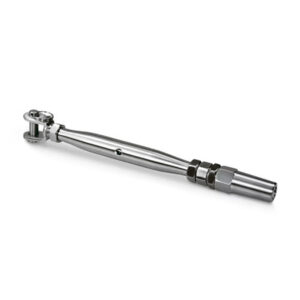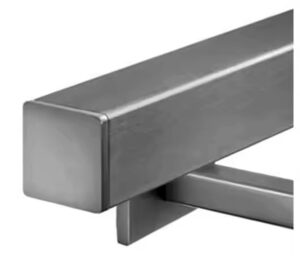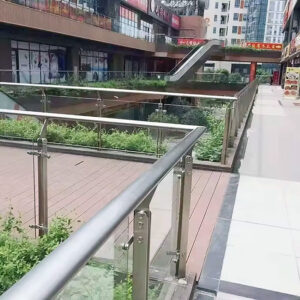Finding reliable post to glass adapters that actually perform as specified isn’t as straightforward as it should be. After 23 years in the stainless steel hardware business, we’ve seen too many projects delayed by incompatible components, code compliance issues, and systems that fail under real-world conditions. The solution lies in understanding which adapter configurations work for specific applications, how different stainless grades perform in various environments, and what installation methods actually save time and money on the job site.
Core Adapter Systems & Performance Specifications
Glass Panel Connection Hardware
Post-mounted glass adapters form the backbone of modern glass railing systems. These components secure glass panels to structural posts while accommodating thermal movement and wind loads. Key configurations include:
- Through-post adapters: Direct glass-to-post connection with structural continuity
- Side-mount systems: Modular adapters for post-mounted glass panel installation
- Adjustable clamp assemblies: Field-adjustable components accommodating glass thickness variations
- Structural spigots: Base-mounted glass support systems with integrated post connections
Material specifications matter significantly in adapter performance. 316L stainless steel provides superior corrosion resistance for marine and coastal applications, while 304 stainless offers cost-effective performance for standard commercial environments. Surface treatments—brushed versus mirror polish—affect both durability and maintenance requirements.
Custom Fabrication Capabilities
Our post glass adapter fabrication 316L capabilities address projects requiring non-standard configurations. Twenty-three years of manufacturing experience taught us that standardization reduces costs, but custom solutions solve real problems. Common custom applications include:
- Modified mounting dimensions for existing structural conditions
- Specialized load ratings exceeding standard configurations
- Integrated drainage systems for harsh weather environments
- Compatibility adapters linking different manufacturer components
Marine grade post-to-glass hardware ODM services support distributors requiring private-label solutions. This includes engineering support, prototype development, and production scaling based on proven manufacturing processes.
Commercial System Integration
Commercial post glass adapters must balance performance with installation efficiency. Modular systems reduce field assembly time while maintaining structural integrity. Standard components that actually fit together eliminate the costly delays contractors face with mixed-vendor systems.
System compatibility extends beyond individual components. Post-to-glass connections must integrate with handrail mounting, intermediate supports, and end terminations. Our adapter systems accommodate these requirements through standardized connection methods and consistent manufacturing tolerances.
Technical Specifications & Performance Data
| Material Grade | Environment | Typical Applications | Service Life |
|---|---|---|---|
| 304 Stainless | Interior/Protected | Commercial, residential | 15-20 years |
| 316 Stainless | Coastal/Marine | Waterfront, industrial | 20-25 years |
| 316L Stainless | High-corrosion | Chemical, marine | 25+ years |
| Adapter Type | Glass Thickness | Load Capacity | Installation Time |
|---|---|---|---|
| Through-post | 1/2″ – 3/4″ | 200 lbs/linear ft | 15 min/connection |
| Side-mount | 3/8″ – 5/8″ | 150 lbs/linear ft | 10 min/connection |
| Spigot system | 1/2″ – 3/4″ | 180 lbs/linear ft | 20 min/connection |
Load capacities reflect testing per IBC and local code requirements. Installation times assume standard tools and experienced installers working with properly prepared posts and glass panels.
▶ Get Detailed Product Specs ◀
Real Project Applications & Results
Residential Multi-Unit Housing
A 240-unit housing development required custom post glass systems balancing safety compliance with construction budgets. Standardized adapter configurations reduced installation time by 35% compared to custom fabrication approaches. Post-to-glass connections used 316 stainless components for durability, while maintaining cost efficiency through modular design.
The project integrated multiple glass panel heights with consistent post spacing. Adapter systems accommodated 1/2-inch tempered glass panels with structural loads exceeding local code requirements. Installation teams completed railing sections 40% faster than previous projects using mixed-vendor components.
Commercial Office Complex
A downtown office renovation required glass railing systems meeting ADA compliance and architectural design standards. Precision adapter manufacturing capabilities provided custom mounting solutions for existing structural conditions while maintaining standardized connection methods.
“Modular adapter systems reduced field coordination time significantly while ensuring consistent installation quality across multiple building levels.” —Regional Contractor Association
The project specification required 316L stainless components throughout, with brushed finish for reduced maintenance. Adapter systems accommodated thermal movement between glass panels and steel structure, preventing stress concentrations that cause premature failure.
Marine Industrial Facility
Coastal manufacturing plants present challenging conditions for glass railing systems. Salt air, temperature cycling, and industrial chemicals demand marine grade post-to-glass hardware ODM solutions engineered for extended service life.
This facility used 316L stainless adapters with specialized gasket systems preventing water infiltration. Post-to-glass connections included integrated drainage preventing ice formation and corrosion accumulation. After three years of service, systems show minimal corrosion with reduced maintenance compared to previous installations.
Installation metrics:
- 180 linear feet of glass railing completed in 4 days
- Zero component compatibility issues during installation
- 60% reduction in maintenance calls versus previous system
▶ Discuss Your Specific Project Requirements ◀
Installation Support & System Integration
Modular Assembly Methods
Post to glass adapters designed for field installation efficiency use standardized connection methods. Pre-drilled mounting points, consistent fastener specifications, and modular adjustment capabilities reduce installation variables that cause delays.
Standard tooling requirements include impact drivers, torque wrenches, and glass handling equipment. Installation guides specify proper sequence and torque values preventing component damage during assembly. Quality control checkpoints ensure structural integrity before system commissioning.
Engineering & Technical Support
Twenty-three years of manufacturing experience provides practical installation knowledge beyond component specifications. Common field challenges include:
- Structural post alignment affecting adapter fit
- Glass panel dimensional tolerances requiring adjustment
- Code compliance verification for specific jurisdictions
- Load path continuity through complete railing systems
Our technical team provides installation support, design verification, and troubleshooting assistance. This includes review of mounting conditions, load calculations, and compatibility verification for mixed systems.
Supply Chain & Inventory Management
Precision adapter manufacturing capabilities support just-in-time delivery and inventory optimization for distributors and contractors. Standard lead times typically range 2-4 weeks for stock configurations, with expedited delivery available for urgent projects.
Batch coordination ensures consistent material properties and surface finish across complete projects. Component serialization supports quality tracking and warranty administration throughout system service life.
▶ Connect with Our Technical Team ◀
Frequently Asked Questions
What stainless steel grade works best for different environments?
304 stainless provides cost-effective performance for interior and protected applications with 15-20 year service life. 316 stainless offers superior corrosion resistance for coastal environments and high-humidity conditions. 316L provides maximum corrosion resistance for chemical exposure and severe marine conditions, with service life exceeding 25 years under proper maintenance.
How do adapter systems accommodate different glass thicknesses?
Standard adapters accommodate glass thickness ranges through adjustable clamping mechanisms. Typical ranges include 3/8″ to 5/8″ for light-duty applications and 1/2″ to 3/4″ for structural systems. Custom adapters handle non-standard glass dimensions while maintaining structural performance requirements.
What installation time should contractors expect?
Modular adapter systems typically require 10-20 minutes per connection point using standard tools. Installation time varies based on post preparation, glass handling requirements, and access conditions. Proper planning and component staging reduces total installation time by up to 40% compared to custom fabrication approaches.
How do adapter systems ensure code compliance?
Standard adapter configurations meet IBC load requirements and local safety codes through documented testing and engineering calculations. Load ratings account for wind loads, occupant loads, and safety factors required by building codes. Engineering support includes load path verification and compliance documentation for permit approval.
What compatibility exists between different manufacturer systems?
Esang Metal adapter systems use industry-standard connection methods maximizing compatibility with various post and glass systems. However, performance verification remains essential when mixing components from different manufacturers. Our technical team provides compatibility analysis and integration support for complex projects.
How does manufacturing precision affect installation success?
Precision adapter manufacturing ensures consistent fit between components, reducing field adjustment time and installation delays. Tight manufacturing tolerances prevent compatibility issues causing costly rework. Quality control processes verify dimensional accuracy and material properties before shipment, supporting predictable installation outcomes.
| Performance Factor | Standard Tolerance | Impact on Installation |
|—|—|—|—|
| Mounting hole spacing | ±0.005″ | Direct bolt-up assembly |
| Glass clamp dimensions | ±0.002″ | Consistent panel fit |
| Thread specifications | Class 2A/2B | Reliable fastener engagement |
| Surface finish consistency | 32 RMA max variation | Uniform appearance |
Market Position & Selection Criteria
| Selection Factor | Our Advantage | Alternative Options | Best Application |
|---|---|---|---|
| Manufacturing experience | 23 years proven performance | Newer market entrants | Complex custom projects |
| Material consistency | Certified mill test reports | Variable supplier quality | Critical applications |
| Technical support | Engineering assistance included | Limited post-sale support | First-time installations |
| Delivery reliability | Established supply chain | Uncertain lead times | Schedule-critical projects |
Honest assessment: Our systems excel in applications requiring proven reliability, technical support, and custom solutions. Contractors prioritizing lowest initial cost may find alternatives suitable for straightforward installations with standard requirements.
Selection criteria should consider total project cost including installation time, long-term performance, and support availability rather than component cost alone. Twenty-three years of experience demonstrates which approaches provide genuine long-term value versus apparent short-term savings.
